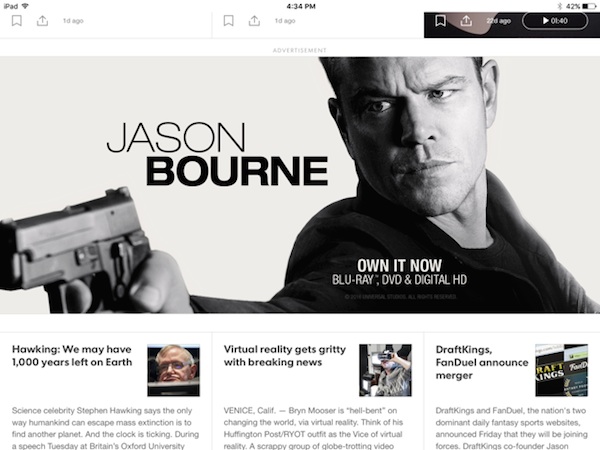
USA Today Network is the latest publisher to take a crack at reinventing the display ad with the introduction of new custom ad formats.
USA Today Network built new ad formats, called Paramount, that are informed by data on the thousands of ads that run across its 109 local newspaper sites plus USA Today. So far this year, the network has run some 2,500 ad campaigns just in automotive and 3,500 health/medical-related campaigns, for example.
“It’s the display ad, but better,” said Jeff Burkett, vp of ad innovations at USA Today Network. “These are proprietary formats we think are going to have advertising perform better, and readers will like them. I think you’ll start to see more ads that are built this way.”
The process to build the new formats began a year ago when Burkett joined the company from a sales and product role at The Washington Post. Burkett had paid close attention to the rise of ad blocking and wanted to come up with new ad formats that performed for advertisers but weren’t annoying to readers.
USA Today Network had the benefit of its big newspaper network to draw from. Using a new internally built data platform called Grandstand, data scientists measured ad performance on a variety of metrics, including interaction rate, attention quality and hover time. Some of the takeaways were that an ad’s clarity of message made a big difference in ads’ performance, but font didn’t.
The new suite of ad formats that resulted consists of five formats, including three types of video ads, a carousel and static one. They’re all made for desktop and mobile devices. (Examples of Samsung and “Jason Bourne” ads appear below.)


Advertisers are shifting dollars to branded content and programmatic. Burkett said the ads will have branded-content versions and will eventually also be available programmatically. Programmatic advertising is perceived as a lower-cost way to buy advertising, but Burkett said he still expects the new ads to be sold at a “slight” premium over standard display ads. “I’m hearing demand for these kind of units programmatically to be quite high. We are expecting to see higher-than-average CPMs.”
More than 15 advertisers have run the new ads since the beginning of 2017, including Dell, Principal Financial Group, the United MileagePlus Explorer Card issued through Chase and Google’s Daydream virtual reality headset. According to USA Today Network, across those campaigns, the new ads have had a sevenfold higher interaction rate and a 31 percent higher viewability rate than the average campaign, as measured by Moat.
Grandstand also is accessible to USA Today Network’s ad designers, who for the first time will be able to see how ads performed and use that data to inform future ads.
Convincing advertisers to buy custom ads is always a challenge. With USA Today’s new platform, advertisers provide the ad components, and the publisher then assembles them. By controlling the process, USA Today Network can also have more control over the ad load time. Today, Paramount accounts for a small percent of the publisher’s inventory, but Burkett expects that to increase by the end of the year.
“Anything custom is harder to sell,” Burkett said. “But advertisers are definitely looking for newer and unique ideas all the time. We hope by making them quicker to build and change, it’ll help.”
More in Media

Condé Nast and Hearst strike Amazon AI licensing deals for Rufus
Condé Nast and Hearst have joined the New York Times in signing a licensing deal with Amazon for its AI-powered shopping assistant Rufus.

Media Briefing: AI payouts may be entering a new era
AI compensation is evolving — and new models, not just publisher demands, are driving the shift beyond flat-fee licensing.

In Graphic Detail: AI platforms are driving more traffic — but not enough to offset ‘zero-click’ search
Here are five graphs that reveal the major trends emerging in the world of AI and ‘zero-click’ search, and what it means for publishers.





